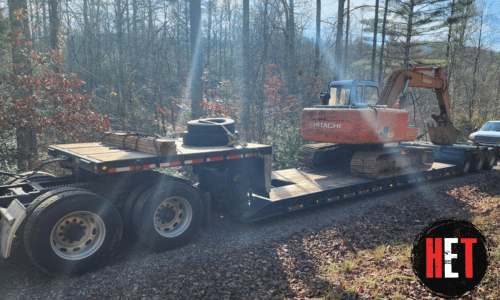Understanding the Costs of Heavy Equipment Shipping: Factors That Influence Pricing

Updated October 20, 2025
Shipping heavy equipment is essential in numerous industries, including:
- • Construction
- • Mining
- • Agriculture
- • Manufacturing
- • And other industries.
These companies rely on being able to move essential equipment from location to location or job site to storage.
Transporting heavy and oversize loads requires cautious planning, a focus on safety, and, ensuring you’ve got an accurate and reliable shipping quote. One without any hidden fees.
You need a price that holds and a delivery window you can plan around. We keep equipment shipping cost clear by focusing on the basics:
- • Weight
- • Dimensions
- • Route
- • Permits
- • Trailer type
- • Timing
This blog delves into the complexities of heavy equipment hauling rates to provide a clearer perspective for anyone navigating this complex terrain and to help you understand how much you might need to budget for.

General Equipment Hauling Rates
Equipment hauling rates aren’t one-size-fits-all. They rise and fall based on market conditions, your specs, and the route. In simple terms, short hauls usually cost more per mile. Longer lanes spread fixed costs and trend lower per mile. The total equipment shipping cost still depends on the job in front of us.
Rates start with linehaul and build from there. We add fuel, permits, escorts, and any load assistance. That structure makes your cost to ship heavy equipment transparent and easier to compare.
When it comes to this type of equipment, it isn’t just about how far you need to transport the equipment. It’s also the type of transport trailer you use.
| Trailer Type | Cost Per Mile |
| Flatbed, Stepdeck, Dry Van Trailers | $3.00 – $3.50 |
| RGN and Lowboy Trailers | $3.50 – $4.00 |
| Hot Shot Trailers | $2.00 – $2.50 |
It’s important to note that per mile rates begin at about 300 miles. Anything less than that will get a “day rate” which varies.
Again, this chart is just for standard equipment. That means it falls into the standard transport guidelines. Anything that becomes an oversize load, whether it’s overweight, overheight, or overlength, incurs additional costs.
For instance, an RGN with more axles to carry an overweight load, costs more than the standard $3.50 to $4.00 per mile.
Remember, this is just an average. The best way to get an accurate shipping quote for your equipment is to speak with a Heavy Equipment Transport specialist today. (888) 260-1649

Factors That Influence the Cost of Heavy Equipment Hauling
“When you speak with a Heavy Equipment Transport specialist, they’ll provide you with everything you need for an accurate quote and will let you know what you can do to reduce costs.”
Fuel Prices
Diesel swings impact the linehaul through a fuel surcharge. We tie that line to published diesel averages, so you see how fuel moves the final rate.
Specialized Permits/Regulations
Oversize and overweight loads need permits that vary by state. Thresholds for width, height, axle weights, and travel hours affect routing and cost. We pull permits and plan the route before wheels move.
Insurance
High-value assets may require higher cargo limits. We provide certificates on request and align coverage with your risk requirements.
Seasonality
Construction season and harvest push demand. Winter storms can slow certain lanes. Booking early helps protect your timeline and price during peak periods.
Pilot Cars if Necessary
Some dimensions trigger escorts. Your quote will show the number of pilot cars, where they’re needed, and how they affect timing.
Load Assistance if Necessary
Cranes, forklifts, ramps, and rigging crews can be part of the plan. We’ll spell out what’s needed at loadout and unload so there are no surprises on site.
Transport Your Heavy Equipment Today
Heavy Equipment Transport is always available for a quote. Fill out the form or give us a call now! (888) 730-2951
Red Flags in Equipment Transport Quotes
We see most problems start with unclear quotes. Watch for these common issues and push for straight answers.
- • Vague or missing cost breakdown. No clear linehaul, fuel, permits, escorts, or load support.
- • Unusually low or high pricing. Outliers often mean missed details or shaky capacity.
- • No mention of permits or escorts. Oversize loads need them, so a missing line suggests guesswork.
- • No clear timeline or delivery window. You need a realistic range based on driver hours and state rules.
- • Missing carrier or insurance information. Ask for USDOT/MC and a current certificate of insurance.
- • Lack of written confirmation. Get specs, rate, and terms in writing.
- • No dedicated point of contact. One rep should own your load from quote to delivery.
- • No mention of equipment type or load specifics. Quote should match your machine, dimensions, weight, and trailer plan.
- • Poor responsiveness or evasive answers.Slow or vague replies now mean trouble later.
- • Request for full payment up front. Normal practice uses deposits or on-delivery terms by agreement.
A clean, itemized quote saves time and makes comparisons simple.
Ways to Reduce Your Equipment Transport Costs

You can lower spend without risking schedule or safety. Here are practical ways on how to reduce equipment shipping costs.
- • Plan ahead: More lead time opens better routing, capacity, and pricing.
- • Compare carriers: Ask for itemized quotes so you compare apples to apples.
- • Disassemble equipment: Bring height or width within legal limits to avoid permits and escorts where possible.
- • Consolidate: Combine units or plan backhauls to spread mobilization costs.
- • Shipment methods: Choose the trailer that fits your dimensions without overbuying capacity.
When you speak with a Heavy Equipment Transport specialist, they’ll provide you with everything you need for an accurate quote and will let you know what you can do to reduce costs.
How to Choose an Equipment Hauling Partner
Price matters, but execution carries the day.
- • Ask for multiple written quotes based on the same specs.
- • Verify DOT/MC authority and insurance.
- • Confirm permit and escort experience on similar lanes.
- • Request the trailer plan, deck height, and axle layout.
- • Require one point of contact with an agreed update schedule.
For oversize work, see our oversized load transport solutions. For containers, our container moving services cover drayage, lifts, and inland legs.
Choosing Heavy Equipment Transport as Your Shipping Partner
We make complex moves feel straightforward. You get a dedicated rep, itemized pricing, and route and permit planning handled from day one. We coordinate pilot cars, load assistance, and site access. We cover your lanes in all regions and keep you updated without phone tag.
Ready to price your next move? Use our form to get a fast estimate, or contact our team. Call 888-264-5276 if you want to book now.

Equipment Shipping Cost FAQ
- 1. How are heavy equipment shipping costs calculated?
Miles times a per-mile linehaul, plus fuel surcharge, permits, escorts if needed, insurance, and any load support like cranes or forklifts.
- 2. What factors can cause my transport quote to change?
Updated dimensions or weight, route changes, weather detours, schedule shifts, or added load assistance. - 3. Does Heavy Equipment Transport handle permits and route planning?
Yes. We pull permits, plan routes, and schedule escorts before pickup. - 4. How far in advance should I schedule my equipment shipment?
A few weeks is smart in peak seasons. Off-peak moves can be faster. Share your dates, and we’ll advise.
- 5. What’s included in a Heavy Equipment Transport quote?
An itemized breakdown. Linehaul, fuel, permits, escorts, insurance terms, trailer plan, and pickup and delivery windows.

William Thomas
Heavy Transport Specialist
Being able to lead a team of such talented logistics agents has been a wonderful experience over the past ten years. If you would like to know anything more about the heavy equipment transport services we offer, don't hesitate to give us a call!